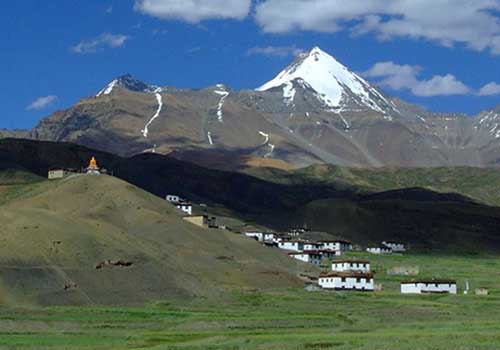Lahaul and Spiti are two remote Himalayan Valleys of H.P. lying on the Indo-Tibet border. Strange, exciting, primitive, these valleys are unsurpassed in mountain scape, in the rugged beauty of their rocky escapements and the splendor of their snow covered peaks.
Lahaul
Lahaul is marked by a central mass of uniformly high mountains and massive glaciers. The two rivers, Chandra and Bhaga which rise on either side of the Baralacha La, flow through the narrow Chandra and Bhaga valleys. Lahaul is a land of fascinating Buddhist art and culture. The monasteries of Lahaul-Spiti are rich repositories of ancient murals, thankas, wood carving and golden images of Padmasambhava. The valley lies at a height of 2745 metres above sea level. Summer in this valley is cool and pleasant with green grass and alpine flowers. There are little monsoon in both these valleys and this enables climbers & trekkers to enjoy a long and unbroken season in perpetual sunshine to explore the wilderness and grandeur of the inner Himalaya. This unique feature makes Lahul-Spiti as an ideal destination for tourists and trekkers in the month of July, August and September. Keylong is 115 kms. from Manali and is the District Headquarters of Lahul-Spiti District.
Spiti
 Spiti is the sub division of Lahaul & Spiti district with its hqrs. at Kaza. It is called “Little Tibet” because it has almost the same terrain, vegetation & climate . Spiti also means “Middle Country”. It lies between Tibet, Ladakh, Kinnaur, Lahaul & Kulu. From Shimla via Kinnaur there is a motorable road which remains open upto Kaza for 8 to 9 months. About 10kms. ahead of Pooh, satluj enters India near Shipki la & Spiti river joins it at Khab. The road then goes to Sumdo via Hangrang valley. From Sumdo Spiti valley starts. The Spiti river flows fast through deep gorges at some places. The valley is not wide but there are villages and some fields where people grow barley, buck- wheat, peas & vegetables. It has an area of 4800 sq. kms. Some inhabitants have adopted Budhism as there faith and Bhoti is the spoken language. The people are simple and honest. The main Spiti valley is split into eastern and western valleys. They are connected with Ladakh & Tibet on eastern side & Kinnaur and Kulu on western side through high passes.
Spiti is the sub division of Lahaul & Spiti district with its hqrs. at Kaza. It is called “Little Tibet” because it has almost the same terrain, vegetation & climate . Spiti also means “Middle Country”. It lies between Tibet, Ladakh, Kinnaur, Lahaul & Kulu. From Shimla via Kinnaur there is a motorable road which remains open upto Kaza for 8 to 9 months. About 10kms. ahead of Pooh, satluj enters India near Shipki la & Spiti river joins it at Khab. The road then goes to Sumdo via Hangrang valley. From Sumdo Spiti valley starts. The Spiti river flows fast through deep gorges at some places. The valley is not wide but there are villages and some fields where people grow barley, buck- wheat, peas & vegetables. It has an area of 4800 sq. kms. Some inhabitants have adopted Budhism as there faith and Bhoti is the spoken language. The people are simple and honest. The main Spiti valley is split into eastern and western valleys. They are connected with Ladakh & Tibet on eastern side & Kinnaur and Kulu on western side through high passes.
Giu Village: Located near the Indo-Tibet border, the village has a naturally preserved unique Mummy, which is more than 500 years old and is an attraction for the visitors. The village Giu is situated at a height of approx 10,000 feet above the sea level. The mummy in the village is placed in a room constructed on a hilltop. It is believed that this mummy is of a Lama, who died at the age of around 45 years and was found in a sitting posture. Presently, the mummy is kept in an open glass box. Giu village is approximately 10 km from Giu nallah and village is connected with link road. Giu nallah is between Sumdo and Tabo.
General Information about Lahaul and Spiti
Area: 13835 sq. km, Population: 33,224, Altitude: 3340 m (Keylong)
Clothing: Light woollen in Summer and Heavy woollen in Winter.
Temperature: Maximum:26.8 C Min 1.38 C Summer
Maximum:6.1 C Min (-)19.38 C Winter
Visiting season: June to October
Languages: Lahauli, English, Hindi, Bhoti are understood and spoken by the people engaged in tourism trade.
Religion: Hinduism & Budhism
How to Reach Lahaul and Spiti
Lahaul is connected with road from all parts of the country. Manali is the point where buses from various stations come. From here, one can take bus/taxi to any destination in Lahaul-Spiti, Pangi & Leh during the months between June to November depending upon opening and closing of Rohtang pass (3979 m), the gateway to this valley. National highway 21 is passes through this valley enroute to Leh.
There are two routes to enter Spiti.
From Manali via Rohtang Pass to Kaza, the hqtr. of Spiti. Manali is connected by Air, Rail and Road. From Manali, there is a regular bus from July to October.
From Shimla via Kinnaur. Shimla is connected by Air, Rail & Road. From here by buses to Kaza from May to October.